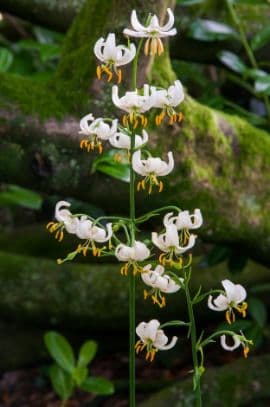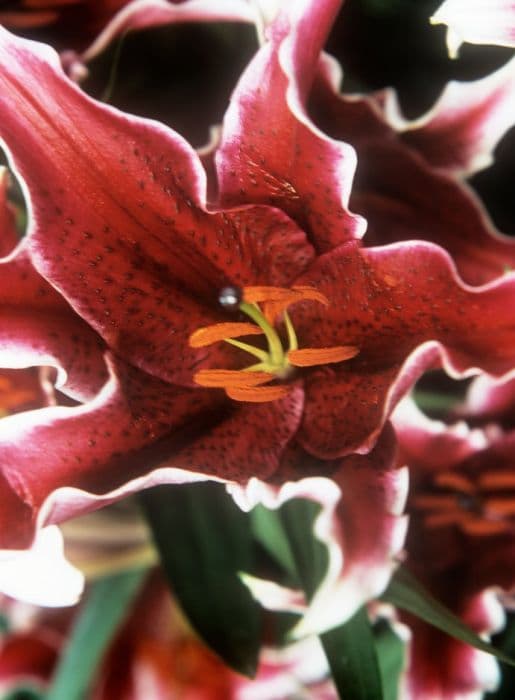Tulip Tulipa 'Parade' (4)

ABOUT
Tulipa 'Parade', more commonly known as the tulip 'Parade', is a striking variety that displays vibrant color and classic form, typical of tulips. It features large, bold flowers on sturdy stems that bloom in mid to late spring. The blossoms are cup-shaped with a slightly pointed tip, often described as being shaped like a wineglass. The petals have a lustrous, velvety texture and boast a rich, deep red hue that can appear almost maroon in certain light, with a fine golden-yellow edge that outlines the petals and adds an attractive contrast. Inside the flower, you can spot a base color of yellow or sometimes black, which creates a dramatic effect against the red petals. This contrasting base is often surrounded by a white or light-colored halo that further highlights the striking coloration of the bloom. The leaves of the tulip 'Parade' are broad, green, and sword-shaped, growing at the base of the stem in a clump. The foliage provides an elegant backdrop to the spectacular flowers and accentuates the robust color. Overall, the tulip 'Parade' is renowned for its commanding presence in the garden, with its splendid flowers making a flamboyant statement against the fresh greenery of spring. It is often used for mass plantings, borders, and as a highlight in floral arrangements due to its long-lasting and show-stopping blooms.
About this plant
 Names
NamesFamily
Liliaceae
Synonyms
Parade Tulip, Darwin Hybrid Tulip
Common names
Tulipa 'Parade'
 Toxicity
ToxicityTo humans
The Tulipa 'Parade' is a variety of tulip. While tulip bulbs contain certain compounds that can be toxic when eaten in large quantities, the toxicity level of tulips to humans is generally considered low. Upon ingesting tulip bulbs, a person might experience symptoms such as nausea, vomiting, diarrhea, and abdominal pain. In rare cases, an allergic reaction can occur, which may include skin irritation or dermatitis from handling the bulbs or plant.
To pets
Tulips, including the Tulipa 'Parade', are toxic to pets. The bulbs are the most poisonous part of the plant and, if ingested, can cause symptoms such as gastrointestinal irritation, drooling, loss of appetite, changes in heart rate and respiration, or even convulsions. In severe cases, consuming tulip bulbs can lead to central nervous system depression and can be fatal, especially to smaller animals. It's important to keep pets away from tulips to prevent accidental ingestion.
 Characteristics
CharacteristicsLife cycle
Perennials
Foliage type
Deciduous
Color of leaves
Green
Flower color
Red
Height
1 feet 2 inches (35 cm)
Spread
6 inches (15 cm)
Plant type
Bulb
Hardiness zones
3
Native area
Asia
Benefits
 General Benefits
General Benefits- Adds vibrant color: Tulip 'Parade' is known for its beautiful, deep red flowers that can add a splash of color to gardens and landscapes.
- Easy to grow: They are relatively easy to plant and maintain, making them a good choice for both novice and experienced gardeners.
- Spring bloomers: Blooming in the spring, they provide an early burst of flowers after the winter months.
- Attracts pollinators: Their bright flowers attract bees and other pollinators, which are important for the health of the garden ecosystem.
- Bulb perennial: As a bulb plant, they can come back year after year when planted in the right conditions, providing long-term garden interest.
- Landscape versatility: They are versatile in landscape use, from borders and flowerbeds to pots and containers.
- Cut flower use: Tulip 'Parade' makes an excellent cut flower due to its strong stems and vibrant color, lasting well in vases.
- Symbolism and cultural significance: Tulips are often associated with love and spring, bringing cultural and symbolic value to gardens and bouquets.
 Medical Properties
Medical PropertiesThis plant is not used for medical purposes.
 Air-purifying Qualities
Air-purifying QualitiesThis plant is not specifically known for air purifying qualities.
 Other Uses
Other Uses- The crushed petals of tulips can be used as a natural dye for fabrics, providing a range of colors from soft pastels to more vibrant hues depending on the concentration.
- Tulip petals are sometimes used in gourmet cooking as an edible decoration, adding a floral touch and splash of color to salads and desserts.
- In craft projects, tulip petals and bulbs can be pressed and used for creating unique botanical prints on paper or fabric.
- As a theme in jewelry, tulip shapes are often used in designs, with some artists incorporating actual parts of the flower encased in resin.
- In photography, the vibrant colors and elegant shapes of tulips serve as a popular subject for botanical and macro photography.
- During certain festivals, tulips are used to create large scale floral mosaics and artworks, which can be displayed in public spaces.
- Aromatherapists sometimes use the scent of tulips, though not as common as other flowers, to create calming and uplifting fragrances.
- Tulip bulbs can be hollowed out and used as natural containers or biodegradable planters for starting small seedlings.
- The shape and structure of tulip flowers inspire designs in architecture and home decor, influencing patterns and motifs.
- In some educational settings, parts of the tulip plant are used in science classes to help teach botany and the life cycle of plants.
Interesting Facts
 Feng Shui
Feng ShuiThe Tulip is not typically used in Feng Shui practice.
 Zodiac Sign Compitability
Zodiac Sign CompitabilityThe Tulip is not used in astrology practice.
 Plant Symbolism
Plant Symbolism- Perfect Love: The tulip is often associated with ideal and perfect love, conveying a sense of deep emotion and affection towards someone.
- Royalty and Nobility: Due to its historical significance in the Ottoman Empire and its prominence during the Dutch Golden Age, the tulip represents wealth, royalty, and high status.
- Eternal Life: In some cultures, the tulip's vibrant bloom, which emerges in spring, is seen as a symbol of renewal and the eternal cycle of life.
- Fame and Showiness: The bold colors of the tulip, especially the red 'Parade' variety, symbolize fame, showiness, and the admiration one might receive from others.
 Water
WaterThe tulip 'Parade' should be watered thoroughly when the soil feels dry to the touch, approximately once a week during the growing season. It's essential to avoid overwatering as this can lead to bulb rot. Provide enough water to soak the ground around the bulb, using about 1 gallon of water per square foot every time you water. Cut back on watering once the flowers have died back, and the leaves begin to yellow and wither, indicating the plant is entering dormancy. During dormancy, water sparingly, only to prevent the soil from completely drying out.
 Light
LightTulip 'Parade' thrives best in full sun exposure, with at least 6 hours of direct sunlight daily. Ideal locations include a spot in your garden that receives unobstructed morning and early afternoon sun. It's essential to ensure the light is consistent throughout the growing season to ensure healthy growth and optimal flowering.
 Temperature
TemperatureTulip 'Parade' prefers a temperature range of 60-70 degrees Fahrenheit during active growth, with cooler temperatures of about 55 degrees Fahrenheit at night. These plants can survive temporary dips down to 20-25 degrees Fahrenheit but sustained freezing temperatures or very high heat can damage the plants. The ideal temperature conditions align with typical spring weather in many climates, where daytime temperatures are moderate.
 Pruning
PruningTulip 'Parade' requires minimal pruning, mostly to remove spent flowers and to deadhead the plants, which encourages the bulbs to store energy for the following season. Cut back the flower stalks once the petals fall but allow the foliage to remain until it turns yellow and dies back naturally. The best time for pruning is late spring or early summer, after blooming has finished.
 Cleaning
CleaningNot needed
 Soil
SoilParade Tulip (Tulipa 'Parade') thrives in well-draining soil that is rich in organic matter. A mixture of two-thirds loamy soil and one-third compost or well-rotted manure ensures a nutrient-rich base. Sand can be added to improve drainage if needed. The soil pH should be mildly acidic to neutral, around 6.0 to 7.0, for optimal growth.
 Repotting
RepottingParade Tulips typically do not require frequent repotting. They are planted outside as bulbs and should be replanted only every three to five years or when the bulbs become overcrowded. After the blooming season, the bulbs can be lifted, stored dry over summer, and replanted in the fall.
 Humidity & Misting
Humidity & MistingParade Tulip does not have specific humidity requirements. These tulips are typically grown outdoors where humidity is naturally regulated by the environment. Indoors, normal room humidity is acceptable as they are not particularly sensitive to moisture levels in the air.
 Suitable locations
Suitable locationsIndoor
Place Parade Tulips in bright, indirect light indoors; chill bulbs before planting.
Outdoor
Plant Parade Tulips in full sun, in fall, 4-6 inches deep in beds.
Hardiness zone
3-8 USDA
 Life cycle
Life cycleTulip 'Parade' begins its life cycle as a bulb, which is planted in the fall before the ground freezes. During the winter, the bulb undergoes vernalization, a necessary period of cold dormancy that prepares it for spring growth. Come spring, the bulb sprouts and the tulip grows rapidly, producing a sturdy stem, leaves, and a single, brightly colored flower. After flowering, typically in late spring or early summer, the plant directs energy back into the bulb as the leaves photosynthesize. Once the leaves yellow and wither, the tulip enters a period of dormancy throughout the summer and early fall. The bulb remains dormant underground until the next fall, when the cycle restarts with new bulb growth.
 Propogation
PropogationPropogation time
Autumn
The most popular method of propagating the Tulip 'Parade' is through bulb division. The best time to do this is after the foliage has died back and the plant has gone dormant, usually in late summer or early autumn. Carefully dig up the tulip bulbs and gently separate the small offset bulbs, which are called bulbils, from the base of the mother bulb. Each bulbil can be planted immediately, although they typically need one or two seasons of growth before they will bloom. It is important to plant them at the correct depth, which is usually around 6 to 8 inches (15 to 20 centimeters), and to provide well-draining soil. This method capitalizes on the natural reproductive cycle of the tulip, ensuring that the characteristics of the 'Parade' variety are preserved.






![Lily [Roselily Chelsea]](/_next/image?url=https%3A%2F%2Fplants-admin.emdemapps.com%2Fimages%2Fplants%2F%2Fimages%2F604b584f6f830.png&w=640&q=75)


